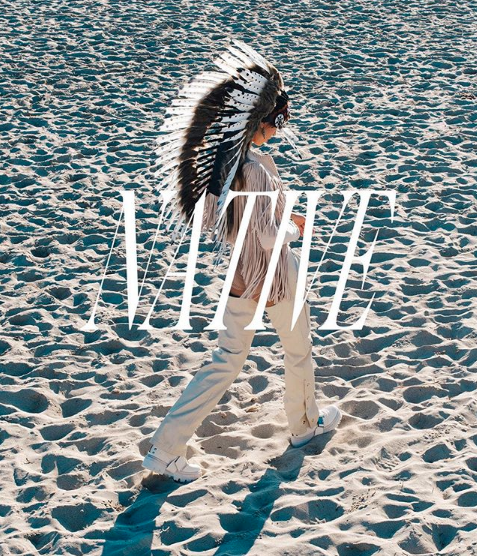Gabrielle Union’s character, Isis, in Bring It On says it best when she says, “Every time we get some, here y’all come trying to steal it, putting some blonde hair on it and calling it something different.” Every year we get to a point where we must continue the conversation of what is and what is not acceptable to wear. Halloween in particular is a hotspot for sparking these conversations when people elect to take garments specifically from marginalized minority cultures and appropriate them for a night of debauchery without recognizing the implications that come along with the clothes.
There’s quite a fine line between appreciation and appropriation, but we can look at it from a perspective of language. A lot of slang these days will come from Twitter and finds its origins in African American Vernacular English (AAVE). Nobody possesses ownership over a word, but the key is in the perceptions of its origin. For centuries, Black people (and all people of color) have been mercilessly mocked, patronized and disrespected for how they speak with specific criticisms in their enunciation, accents and word choice. As time has gone on and the internet has become a melting pot for all cultures, non-Black people have taken to these unique words and adopted them as their own, bringing AAVE into mainstream culture and normalizing it specifically among the youth. This wouldn’t be a problem except for the fact that these non-Black people can now utilize these words and a ‘Blaccent’ for internet clout with zero repercussions or experiencing the isolation Black people have received. AAVE is a concrete example of appropriation within internet spaces. People outside of these communities will try to label their usage of POC words, designs and hairstyles as appreciation, but it is NOT appreciation if you use these things as trends and act differently than the way you actually are.
Knowing what we now know about appropriation in the context of language, we have to understand it in a fashion context. Dressing up as a slutty Pocahontas, a promiscuous geisha, a Mexican stereotype, etc. is Not It. It’s rude, insensitive, tacky and disrespectful to adopt a stereotype, culture or, at worst, skin color for your personal entertainment for a few laughs between you and your friends at the expense of a person of color. Unfortunately, appropriation doesn’t just stop at a yearly holiday. Fashion has a long history of crossing the line when it comes to taking from minority cultures whether it’s Italian-based jewelry brand Nove25 creating their own “NATIVE” jewelry collection and campaign, Kim Kardashian trying to trademark the word Kimono for her shapewear brand, or Justin Bieber sporting dreadlocks a year after Giuliana Rancic commented on Zendaya’s dreadlocks, saying her hair makes her look like she “”smells like patchouli oil or weed.”
DietPrada is an account on Instagram that often features a collection of designers that rip off designs from elsewhere, but they also do a deep dive into cultural appropriation, problematic figureheads, fashion gossip, etc. A stellar example of this can be seen in Ariana Grande’s outfits from the 2019 Sweetener/Thank U Next Tour. DietPrada put the pop singer on blast for her lookbook that was mostly composed of Black women and designs from Yeha Leung, an independent Asian designer. This is a prime example of cultural appropriation: borrowing popular pieces from other cultures for your own personal gain and being glorified for ‘serving a look’ without suffering any consequences for utilizing it — it’s an issue of privilege. To make matters worse, Grande’s team later sued Forever21 to the point of bankruptcy for using the likeness that she appropriated in Daniel the first place in one of their campaigns. Yeha and drag queen Farrah Moan later noted how unfortunate it is that celebrities can take ideas from people of color and queer artists for profit and make it mainstream without even having to credit them. In a similar fashion, Grande’s hit song 7 rings has been criticized heavily for its similarity in sound to Soulja Boy’s Pretty Boy Swag and Princess Nokia’s Mine while also adopting a heavy Black aesthetic for the music video. Regardless of whether Grande, her stylist, her team or her music producers are to blame, someone has to take responsibility for these problems, and unfortunately for her, Ariana is the face of her own brand and takes the backlash for most of these appropriations.
Daniel “Dapper Dan” Day is an American-based fashion designer known for creating the intersection of hip hop music and designer fashion. In his earlier days, it was difficult for Dan to establish himself within fashion spaces as it has been for all Black people. Dan really pushed the envelope by embracing menswear in the fashion industry and creating the today popularized logo monogram pattern that you see from Gucci, Louis Vuitton, Fendi, etc. Gucci in 2017 ended up copying a design that Dan had done for Louis Vuitton without giving him proper credit leading to a social media uproar. This is the inherent problem with appropriation: you take ideas from an artist that, with their culture in mind, created a design that the general population looked down upon. Later on, those ideas are then repurposed by a person from a more privileged culture and it becomes a trend. Gucci later on credited Dan and partnered with him for a capsule collection as reparation.
This now begs the question, “How can we appreciate a culture?” It is possible to immerse yourself in a culture and value what you see and enrich your life. The choice to dress up with cultural garb for one day out of the year that is designated for dressing up in costumes does not equate to appreciation. Culture is not a costume. Learn about the culture, understand the meaning behind these customs, and stand with these cultures in solidarity against their struggles. When you join a culture and develop a better understanding of the history behind these customs, you will develop a respect for the difference between appropriation and appreciation.

